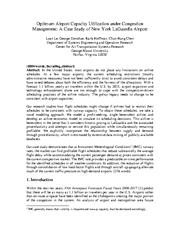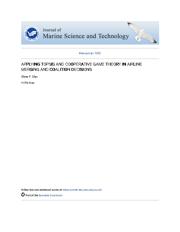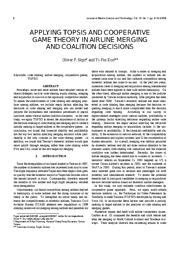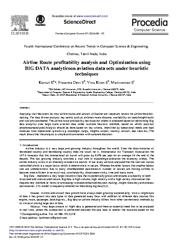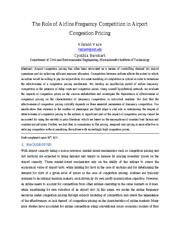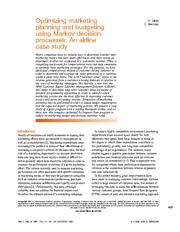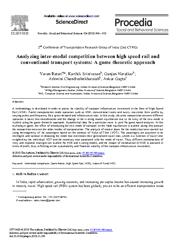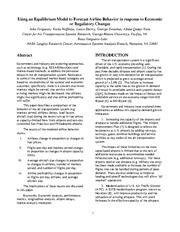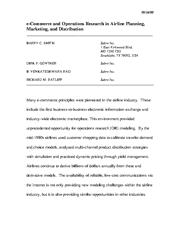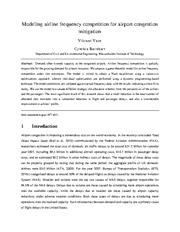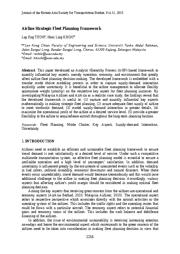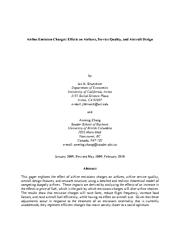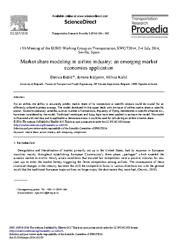A copy of this work was available on the public web and has been preserved in the Wayback Machine. The capture dates from 2017; you can also visit the original URL.
The file type is application/pdf.
Filters
Optimum Airport Capacity Utilization under Congestion Management: A Case Study of New York LaGuardia Airport
2008
Transportation planning and technology (Print)
We model a profit-seeking, single benevolent airline, and develop an airline economic model to simulate its scheduling decisions. ...
This airline is benevolent in the sense that it considers historic pricing at LaGuardia and the associated price-elasticity and attempts to service this population while simultaneously remaining profitable ...
Flight schedules are determined through the interaction of two processes or models: (i) airlines seek profit-maximizing schedules and (ii) airports maximize enplanement opportunities subject to capacity ...
doi:10.1080/03081060701835779
fatcat:5sdvmrfe5zcxxnii4e7ibre5qa
APPLYING TOPSIS AND COOPERATIVE GAME THEORY IN AIRLINE MERGING AND COALITION DECISIONS
2008
Journal of Marine Science and Technology
In addition, we found that Taiwan's domestic airlines would gain more profits through merging rather than code sharing while EVA and CAL could be the best target for merging. I. ...
In conclusion, we found that financial stability and profitability are the top two factors affecting merging decision while profitability is the only concern in the code sharing games. ...
The third assumption describes the fact that the practices of code sharing or merging should be driven by the motivation of profit maximization. ...
doi:10.51400/2709-6998.1992
fatcat:ewdxx6o2qrbb3mq43clxknzxgy
Slam events of high-speed catamarans in irregular waves
2010
Journal of Marine Science and Technology
In addition, we found that Taiwan's domestic airlines would gain more profits through merging rather than code sharing while EVA and CAL could be the best target for merging. I. ...
In conclusion, we found that financial stability and profitability are the top two factors affecting merging decision while profitability is the only concern in the code sharing games. ...
The third assumption describes the fact that the practices of code sharing or merging should be driven by the motivation of profit maximization. ...
doi:10.1007/s00773-010-0105-y
fatcat:vo6x65fnsrgvpe6xq4rhno6jba
Airline Route Profitability Analysis and Optimization Using BIG DATA Analyticson Aviation Data Sets under Heuristic Techniques
2016
Procedia Computer Science
The airline route profitability optimization model is proposed based on performing Big data analytics over large scale aviation data under multiple heuristic methods, based on which practical problemsareanalysed.Analysis ...
For data driven analysis key points such as airliners route distance, availability on seats/freight/mails and fuel are considered. ...
Acknowledgements Analyzed Data set :Australian government -International airline activity [14] Lab: Big Data Analytics lab, Apollo Engineering College, Chennai, Tamil Nadu, India ...
doi:10.1016/j.procs.2016.05.131
fatcat:ztcnk6c4lbckfdq4wteqpszn7m
Airline Frequency Competition in Airport Congestion Pricing
2012
Transportation Research Record
Airlines are typically assumed to be rational decision makers, each driven by its own profit-maximization objective. ...
Also, because airlines are comparatively more reluctant to reduce flight frequency at a higher value, airline profits are lower. ...
The data is loosely based on two major airlines, namely, Delta Airlines (DL) and US Airways (US) operating in each of these two markets. ...
doi:10.3141/2266-08
fatcat:n3mai3g6rzdrfd6suggkcrrdwu
Optimizing marketing planning and budgeting using Markov decision processes: An airline case study
2007
IBM Journal of Research and Development
The title and abstract, but no other portions, of this paper may be copied or distributed royalty free without further permission by computer-based and other information-service systems. ...
We present a case study of a pilot program with a leading European airline, and we show how this company optimized its frequent flyer program to reduce its marketing budget and increase customer value. ...
The fierce competition to be among the preferred airlines of a large corporation leads some airlines to accept corporate contracts that yield little profit. ...
doi:10.1147/rd.513.0421
fatcat:nwpzob4have6tpfpb2aallcv7e
Fleet Planning Decision-Making: Two-Stage Optimization with Slot Purchase
2016
Journal of Optimization
Essentially, strategic fleet planning is vital for airlines to yield a higher profit margin while providing a desired service frequency to meet stochastic demand. ...
The developed model is practically viable for airlines not only to provide a better service quality (via a higher service frequency) to meet more demand but also to obtain a higher revenue and profit margin ...
For other studies, service frequency is optimized in maximizing the profit margin of the airlines. ...
doi:10.1155/2016/8089794
fatcat:if5kr5gtlfb63lvk3pyz3x73ju
Analyzing Inter-modal Competition between High Speed Rail and Conventional Transport Systems: A Game Theoretic Approach
2013
Procedia - Social and Behavioral Sciences
Public transportation mode operators such as HSR, conventional trains and buses, maximize their profits by varying prices and frequency for a given demand and infrastructure cost. ...
Hypothetical data for a particular route is used for game-based analysis. ...
The data based simulation analyzes the sensitivity of the equilibrium state to parameters. ...
doi:10.1016/j.sbspro.2013.11.185
fatcat:koi4xordvjdtjig54i4eo3agx4
Using an equilibrium model to forecast airline behavior in response to economic or regulatory changes
2011
2011 Integrated Communications, Navigation, and Surveillance Conference Proceedings
within existing markets might be decreased, that airfares might rise significantly and that airline profitability will suffer. ...
Airline profitability changes in proportion to flights per day, airfares, and average aircraft size. The implications of these results are discussed in this paper. ...
Airline profitability for the routes serviced is a complex phenomenon driven by demand for air transportation, passenger's responses to price increases, and operating costs. ...
doi:10.1109/icnsurv.2011.5935339
fatcat:r4c4sh3njng5nf2zn5qm2wvtsu
E-Commerce and Operations Research in Airline Planning, Marketing, and Distribution
2001
Interfaces
By the mid-1980s airlines used customer shopping data to calibrate traveler demand and choice models, analyzed multi-channel product distribution strategies with simulation and practiced dynamic pricing ...
Airlines continue to derive billions of dollars annually from these and derivative models. ...
Sabre and SNCF jointly developed a model to assign and route this incremental capacity in the network to maximize profit. ...
doi:10.1287/inte.31.2.37.10627
fatcat:axt4xiux75dkxldrus7rocwxii
Modeling Airline Frequency Competition for Airport Congestion Mitigation
2012
Transportation Science
' profits. ...
The model predictions are validated against actual frequency data, with the results indicating a close fit to reality. ...
Assuming profit maximizing airlines, the number of slots demanded by an airline can be obtained by equating the incremental profitability of the last slot to the congestion price per slot. ...
doi:10.1287/trsc.1120.0412
fatcat:4taoerewi5diljbmotj74gn3z4
Airline Strategic Fleet Planning Framework
2015
Journal of the Eastern Asia Society for Transportation Studies
in making strategic fleet planning, (2) assure adequate fleet supply of airline to meet stochastic demand, (3) model supply-demand interaction in greater details, (4) maximize the operational profit of ...
This paper developed an Analytic Hierarchy Process (AHP)-based framework to quantify influential key aspects, namely operation, economy, and environment that greatly affect airline fleet planning decision-making ...
With the aim to maximize operational profit, Listes and Dekker (2005) adopted scenario aggregation-based approach to determine fleet composition (aircraft choice) to meet short-term stochastic demand ...
doi:10.11175/easts.11.2258
fatcat:iehten67mzc6bpzs66yztkohb4
Airline emission charges: Effects on airfares, service quality, and aircraft design
2010
Transportation Research Part B: Methodological
duopoly airlines. ...
The results show that emission charges will raise fares, reduce flight frequency, increase load factors, and raise aircraft fuel efficiency, while having no effect on aircraft size. ...
Consider the decisions faced by airline 1, which chooses 1 p , 1 e , 1 f and 1 l to maximize profit. ...
doi:10.1016/j.trb.2010.02.006
fatcat:3nfw5xhnfzfzxozieyglktzabe
Integrated Aircraft Scheduling Problem: An Auto-Adapting Algorithm to Find Robust Aircraft Assignments for Large Flight Plans
2012
2012 45th Hawaii International Conference on System Sciences
We developed and implemented algorithms that extend the aircraft routing problem (ARP) by including profit and robustness. ...
Aircraft routing is especially important with respect to timing and costs for an airline. ...
regarding profit maximization [16] . ...
doi:10.1109/hicss.2012.330
dblp:conf/hicss/ReinersPMR12
fatcat:tprnekcdt5h4xp3zv5jbxuq7lm
Market Share Modeling in Airline Industry: An Emerging Market Economies Application
2014
Transportation Research Procedia
The model is illustrated with real data and is applicable to demonstrate how it could be used for calculating an airline's market share. ...
Several explanatory variables, such as: number of competitors, frequency of flying, membership to specific alliances etc., have been considered by the model. ...
The authors would like to thank Bohl Patrick (Head of Airline Business Development at Budapest airport) and Bianca Mamula (PR Specialist at Bucharest airport) for providing data used in model testing. ...
doi:10.1016/j.trpro.2014.10.019
fatcat:5lcthvcbqfgevo5qo7slrztwnm
« Previous
Showing results 1 — 15 out of 4,355 results

